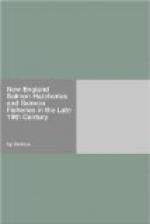Rays in anal fin, 9; scales between gill opening and base of tail, 120; branchiostegals (false gill openings), 11 ..........ATLANTIC SALMON.
Rays in anal fin, 16; scales between gill opening and base of tail, 150; branchiostegals, (false gill openings) 15 to 19..........PACIFIC SALMON.
Numerous instances might be cited of the taking of salmon in the waters of the Atlantic coast in recent years. Their occurrence in the traps and pound nets is in fact so common that it would hardly be entitled to notice at this time were it not for the circumstance that in regions in which salmon were already known there has been a decided increase in the number observed outside the rivers, and that the fish is now being taken in localities in which it was not previously found.
Instances of the capture of salmon in the coast waters of Maine are naturally numerous, and without significance so far as the purposes of the present paper are concerned. The existence of two important salmon rivers, the Kennebec and the Penobscot, affords an easy explanation of the presence of salmon on the shores of either side of the mouths of those streams. In the report of the U. S. Commission of Fish and Fisheries for 1873-73 Mr. Charles G. Atkins, now superintendent of the salmon-rearing establishment at East Orland, Me., and an authoritative writer on the Atlantic salmon, contributes some notes on its occurrence in the sea adjacent to Penobscot Bay and at Richmond Island, near Portland. These cases, however, have little bearing on the subject in hand, as Mr. Atkins suggests in a recent letter.
A special inquiry, personally conducted on Matinicus, Monhegan, and other islands lying far off the Maine coast, and special researches there made with appropriate apparatus, would doubtless disclose many interesting facts regarding the salmon of a practical and scientific nature. A few apparently unrecorded notes concerning the fish among islands off the island of Mount Desert may be given, which are probably indicative of what may be expected in other sections.
Mr. W. I. Mayo, who has fished herring brush-weirs at the Cranberry Isles for many years, and is a life-long fisherman in that section, communicates the intelligence that salmon were first observed about those islands in 1888. On June 17 a salmon, weighing 20 pounds, was taken in a herring weir, and on June 19 another, weighing 19 pounds, was caught. On July 14 of the same year 6 salmon, weighing 4 to 6 pounds apiece, were secured, but were liberated on account of their size. During the four years intervening between 1888 and 1893 none was taken around these islands, but in June of the latter year they reappeared. On June 11 a salmon weighing 15 pounds was taken in a weir, and on various occasions during that month a number weighing 12 to 15 pounds each were caught by boat fishermen on trawl lines fished for cod.
The trawls were baited with herring and set on the bottom in rather deep water. Mr. Mayo states that these were the first salmon ever taken on trawl lines in that region. The Cranberry Isles lie off the southeastern part of Mount Desert Island, and are about 25 miles east from Penobscot Bay and about 35 miles in a straight line from the mouth of the Penobscot River.




